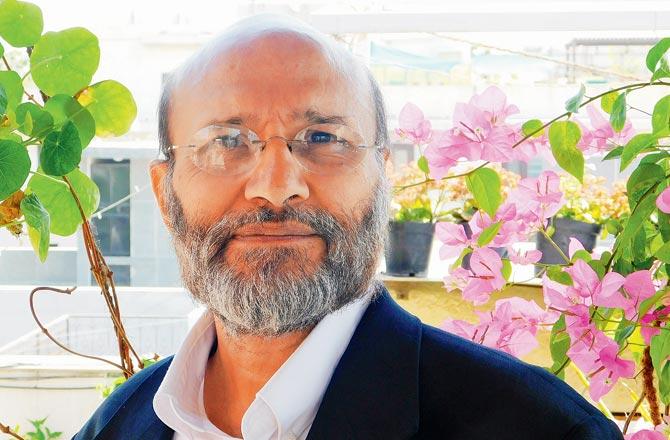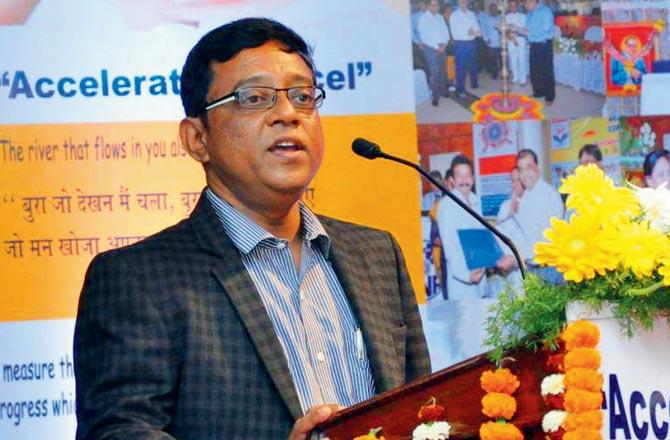The global economic slowdown will make it tougher to navigate financial decisions. Experts tell you what to spend on and where to save

It's like a war broke out," Savio Fernandes says, in an attempt to make sense of the times. "We're being extra cautious indoors and once we step out, we hope and pray that we come back uninfected," he adds.
ADVERTISEMENT
The Vakola resident, an independent consultant and former executive director at JP Morgan & Chase, anticipated the depth of the crisis in early March. He sold his equity investments, despite an opportunity loss. Having promoted well-being in his corporate training sessions, Fernandes, 51, was able to keep calm as the global economic downturn unfolded.

Savio Fernandes
Last month, the IMF projected that the global economy would shrink by three per cent. Last week, Kristalina Georgieva, managing director of the International Monetary Fund (IMF) said, "Incoming economic data for many countries is below our already pessimistic assessment for 2020."
She further stated that the "unknown behaviour" of the Coronavirus is "clouding the horizons for projections." As for India, the country's GDP growth forecast received downgrades from a series of institutions including Nomura, Goldman Sachs and Moody's Investors Services who have estimated zero growth for the current fiscal year.

The recently released book Reviving Jobs: An Agenda for Growth (Penguin India) edited by economist Santosh Mehrotra addresses the unemployment conundrum and provides solutions. Talking about the gravity of the situation, Mehrotra says, "Unemployment had reached a 45-year high at 6.1 per cent in 2018. Youth unemployment has trebled between 2012 and 2018 to 18 per cent. This was before COVID-19 hit us. In March 2020, unemployment reached 23.4 per cent. That means on top of the 30 million already unemployed, an additional 50 million are unemployed."
Change your outlook
Fernandes' primary avenues for investment were real estate and equity. After letting go of the latter and given that he couldn't possibly liquidate real estate right now, he has turned his attention to post office schemes or bank fixed deposits, which he feels are more secure.

Santosh Mehrotra
Having witnessed a steep reduction in his income, he says that it is important to accept that this scenario is not ideal but it has happened; resilience is key. "Don't panic. Introspect and understand it is a phase. Use this time to pursue your passion and maybe convert it into your profession. At the initial stage it might not give you the income as your earlier profession. But if you are passionate about something, eventually you will get recognised for it and that might bring you monetary gains," he suggests.
Cash is king
Natasha Kewalramani, 32, the founder of Miss Manage, a financial literacy platform and community for women, says that this pandemic has been the biggest motivator to realise that if you neglect to manage your money regularly, you will suffer. She plans on maintaining a steady flow of investments and aims to rethink and ready her business for the post-lockdown world, adding, "I will rely less on plastic money, as I always have, and will make sure to keep a cash-only emergency fund handy."

Natasha Kewalramani
To make decisions based on liquidity and assess if you want to follow a cash-driven safety net, Snehdeep Fulzele, investment advisor and author of Die Poor or Live Rich, says that you need to gauge the certainty of employment: take a closer look at the industry you work in and how it's coping, check if your company can be transparent with employees regarding their finances and most importantly, take note of the cash reserve or liquid assets that you already have.
Keep track of your job
Drawing from this assessment, Fulzele advises two approaches. "If your office management is not being transparent enough, opt for the conservative route straight away; conserve cash for as long as you can and redirect funds to deposits in PSU banks. If you think your job will be steady for a year or two, hold your investments. Don't expect high returns now. For those who have disposable income, this is a golden period for Systematic Investment Plans (SIPs). Give it two or three years. The markets might sky-rocket if and when a vaccine is found," he says.

Snehdeep Fulzele
Fulzele adds that given the fear around mutual funds (MFs) at the moment, it is good to have an advisor. He shares, "Not everyone should opt for MFs just because their family is doing so or because there's a campaign that says 'MF sahi hai'. You need to decide your investment horizon — how long do you want the money locked in for?" Fulzele adds that it is also important to remember that MFs are not the only asset capital; the international equities can be explored, too. At the same time, he also states that the advantage of MFs is the fact that it is run as a trust and not a company.
Don't give into temptation
As a measure to cope with the downturn, Fernandes has reduced his consumption to the bare essentials. Fulzele also stresses that irrespective of the current scenario and with brands slashing prices, your expenditure should always be lesser than your income. He says, "The problem is that people give into temptation. Remember that if you run out of money, the government isn't going to bail you out."
The macroeconomic view
In the introduction, Reviving Jobs: An Agenda for Growth outlines that “India risks becoming old without becoming rich.” With the pandemic in the equation now, how do you see this situation changing?
Mehtrotra: First, the demographic forces are in play, and India (like all countries eventually) will become an aging society. That process will suddenly not change just because a pandemic has happened. Our challenges are only set to increase suddenly. Second, what will change is that the pandemic will cause an economic contraction for the first time in India’s economic history, with resulting loss in jobs (formal and informal) that has no parallel in history. That deepens the challenge of realising the demographic dividend in just 20 years. The dividend began in the early 1980s, and will end by 2040; it comes but once in the life of a nation. We still have at least 260 million poor people living below an absolute poverty line (the Tendulkar line, similar to the World Bank’s international poverty line). India was rapidly reducing poverty until 2012; that momentum was lost. Let us stop pretending India has been reducing poverty since then (although some economists have argued that recently).
If we do not repeat China’s incredible performance in growing at 9-10 per cent pa for a 30-year period, during which time they practically eliminated poverty, we risk living in the midst of poverty, illiteracy, malnutrition and ill-health, for decades to come. We have only 20 years left, and no government can lose sight of the urgency; but the COVID pandemic has thrown yet another spanner in the works. India’s governments and people need to first understand the urgency of the jobs crisis, and then act accordingly to resume growth. But we have to make sure that now the growth pattern has to be labour-intensive, much more so than in the last 40 years. If we have been merely walking for the last 40 years, the next 20 years will need to become not merely a jog, but a run.
The times we’re living in has brought on many comparisons with the Great Depression. Would you say this is valid?
Mehrotra: It is not an appropriate comparison at one level, because the causes are different. The Depression was man-made crisis; the pandemic is not. The economic crisis, post-Covid, happened because the novel Corona virus escaped from the Wuhan Institute of Virology (why and how is another question). Second, in the current crisis, governments are dealing with catastrophes at the same time: one health-related, and a second the economic consequences of it. Therefore, it is much worse. The third difference is that 90 years ago, the world economy was not so globally integrated in terms of trade, financial flows, investment, and the flow of people across and within borders.
Migration is a cause of the health crisis, with workers in affected countries returning home, bringing the virus back. The scale of integration means that the economic collapse in one part of the world, has multiplier effects across the globe, including the global South in Latin America, Africa and Asia much greater than 90 years ago. We will wait to see how deep is the economic contraction in India and the world economy, but the main way in which the comparison with the Great Depression is that most economies will suffer an extended shock. It will require sagacious leadership in every country, implying that, at least India’s governments must draw upon the best talent in each field, rather than merely the government’s own decision makers taking most decisions.
You write that the slowdown in growth is a crisis of incomes, driven by non- agriculture jobs barely growing. With the growth forecast slashed for this year, what immediate measures would you like to see put into place by the government?
Mehrotra: A) Without a massive increase in the fiscal deficit, there is little likelihood of growth recovering. None of the other three engines of growth — private investment, household consumption, exports — were firing before the COVID-driven collapse of the economy. Nor was public expenditure, especially public investment, firing, because a silent fiscal crisis had developed by early 2019. But now is the time get public spending engine firing, even though it means a sharp rise in fiscal deficit. A sharp rise in fiscal deficit had occurred after the global economic crisis of 2008, and we saw the economy sharply rebounding as a result. India’s debt to GDP ratio is 68 per cent, well below what it is in Europe, and yet the size of their fiscal response has been far higher than India’s.
Well-known economists have been arguing for a fiscal stimulus worth 3-5 per cent of GDP (or Rs 6 to 10 trillion, or lakh crores). B) How this fiscal stimulus is used is critical. First, it must increase public investment, not government consumption. In particular, the investment has to be in two areas: first, health infrastructure, on which estimates can be provided (India has for three decades been a country where public spending on health is 1.15 per cent of GDP, less than half of that of China, which has a GDP four times as large as India’s), and second, human resources for health, a responsibility of the states, must increase. The gap between northern/eastern states and the southern/western states has to be bridged.
If states are to be allowed to borrow more (all borrowings above the FRBM requirements require approval), there should be agreement that borrowings, within limits, will be for public investment in infrastructure, increasing health expenditure, and household consumption, which has stagnated for several years, causing a collapse in demand, and hence [lead to a] falling share of private investment to GDP, must be incentivized. Government must substitute PM KISAN cash transfer to farmers for a more inclusive minimum income guarantee for 60 per cent of rural and 46 per cent of urban households, the design for which is available with me.
The government must also engage in significant amount of expenditure switching. The amount of fiscal subsidies for non-merit goods is large. Total budget subsidies provided by the central and state governments is 10.3 per cent of GDP. The bulk of these subsidies is provided by the states and about half is spent on non-merit subsidies. Rationalising non-merit subsidies is a deep fiscal reform measures that could release massive fiscal space, about 6 per cent of GDP.
India’s share of manufacturing in GDP (17 per cent) and employment (11 per cent or so) has stagnated between 1991 and 2020. Manufacturing employment between 2012 and 2018. India does not have an explicit industrial strategy, not since 1991. This omission has allowed China to overtake us, with even Ganeshji-Lakshmiji statues at Diwali imported. 100 countries adopted an industrial policy after the 2008 crisis; India has not one even now.
There are eight components of such a strategy: a trade-policy that is aligned to industrial strategy (not one that undermines it as now); policy packages for 5 specific labour-intensive manufactures (textiles, garments, wood furniture, food processing, leather footwear); strengthening cluster development for MSME development; aligning urban infrastructure with clusters; industrial corridor development to engage in global value chains; mineral development as a foundation; creating a design capability and institutions for innovation; and labour reforms and regulatory reforms (all of which I have written in the book).
How will the post-pandemic world change jobs and the way we work?
Mehrotra: The first change is that workers were leaving agriculture between 2004 and 2018; they are now going back. They will take time to return, only when they feel it is safe to return. Second, a safety net has to be created for the unemployed, not through an unemployment insurance, but through a minimum income guarantee, that I mentioned earlier. Nearly 100 million unemployed can exacerbate growing social conflicts. Unemployed youth risk becoming lumpenised and joining fundamentalist groups. Third, for workers in the unorganized sector, India needs to finally create a social insurance system (old age pension, death and disability insurance, maternity benefit). In the organized sector, many services sector jobs will allow work from home, but they constitute a miniscule minority.
Catch up on all the latest Mumbai news, crime news, current affairs, and a complete guide from food to things to do and events across Mumbai. Also download the new mid-day Android and iOS apps to get latest updates.
Mid-Day is now on Telegram. Click here to join our channel (@middayinfomedialtd) and stay updated with the latest news
 Subscribe today by clicking the link and stay updated with the latest news!" Click here!
Subscribe today by clicking the link and stay updated with the latest news!" Click here!








